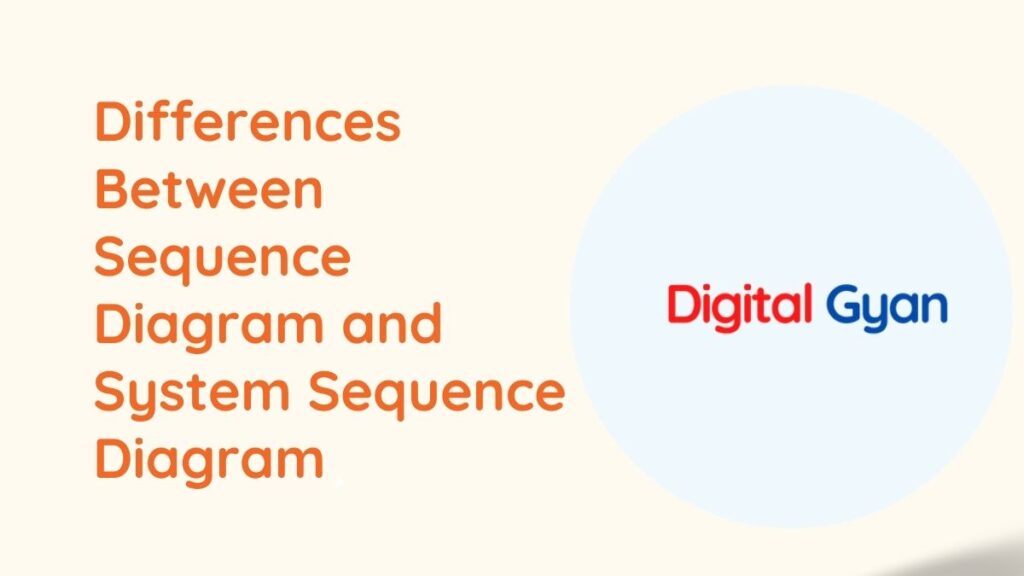Difference between Sequence Diagram and a System Sequence Diagram
Introduction
Unified Modeling Language (UML) offers a standardized method for visualizing and designing software systems. Within UML, several diagram types are utilized to represent different aspects of systems – Sequence Diagrams and System Sequence Diagrams are two frequently seen diagram types which depict aspects of them both; although at first glance these appear similar on paper they both serve different purposes and usage scenarios; this blog post intends to discuss key distinctions between Sequence and System Sequence Diagrams to shed some light on their unique properties and capabilities.
What is a Sequence Diagram?
A sequence diagram is a type of diagram used in software engineering to depict the sequence of messages passing between objects in a system.
It is a graphical tool that helps to visualize the interactions between objects in a system. A sequence diagram shows how objects communicate, and it can help you find problems in your system design. Some permitted types of interactions in a sequence diagram are method calls, returns and exceptions. OCL constraints can be used to define object properties at certain “Points-in-time”.
- Describe the flow of messages, events, and actions between objects
- Show concurrent processes and activations
- Show time sequences that are not easily depicted in other diagrams
- Typically used during analysis and design to document and understand the logical flow of your system
The elements in a sequence diagram are objects (instances of various classes). The messages exchanged by these elements are method invocations.
A system diagram is used to visualise a system constructed from different entities. For example, if you have a system that displays the sequence of interactions between a customer and a company employee (like an order sales process), you would draw a system diagram to show how these two entities are interconnected. In this case, both entities are considered different parts of the system but interact with each other.
Sequence diagrams are particularly useful for identifying potential dependencies between objects and troubleshooting problems. They can also be used to document a system’s design and verify that it meets requirements.
With a sequence diagram, the desired system run can be represented to understand better the system that needs to be implemented. Furthermore, a sequence diagram can define exemplary runs in tests and model test drivers. In sequence diagrams, we need to analyse and document the use cases. Each use case describes the main business task required. The system use case diagram is part of this activity.
Later, we come to design each subsystem, namely each element participating in the system use case diagram. We draw one or more class diagrams depicting the classes participating in the solution. Then we can draw a sequence diagram for the most important (or difficult to understand) methods.

What is a System Sequence Diagram (SSD)?
System Sequence diagrams are graphical, visual representations of systems. They show the system’s components and how they interact with each other. System Sequence diagrams can help you understand how a system works and troubleshoot problems.
A system sequence diagram is made to depict how a system works. They typically depict some states and transitions between them. It is often used in an application for user-to-application communication to indicate how a given state of the application is affected by a transition. A system sequence diagram is used to depict the activities that are performed by a system as a sequence of operations. This graphical representation of activities helps the business analyst generate code in the programming language required to make the system work.
Actors and Systems are participating (exchanging messages) in a system sequence diagram. The messages exchanged by these elements could be of any type depending on the systems (from web service calls to data input from a human).
System Sequence Diagrams define the input and outputs and sequence of interaction between the user and the system for a use case. They are used in conjunction with activity diagrams. In sequence diagrams, information flows in and out of a system called messages. The users are identified, and detailed messages are described.
A sequence diagram, in other words, is used to visualise the execution of a system. For example, if you are building a system where both employees and customers can submit an order, you would draw a sequence diagram of how orders are passed between the customer and the company employee. In this case, both entities are considered different parts of the same system, but they do not interact with each other.
Key Differences Between Sequence Diagrams and System Sequence Diagrams
While both Sequence Diagrams and System Sequence Diagrams are used to visualize interactions within a system, they differ in several key aspects:
Scope and level of detail: Sequence Diagrams provide a more detailed representation of object interactions, focusing on the specific sequence and timing of messages exchanged between objects. Conversely, System Sequence Diagrams offer a higher-level view, capturing interactions between actors and the system as a whole, without delving into the detailed individual object interactions.
Context and actors involved: Sequence Diagrams concentrate on illustrating how objects collaborate within the system, regardless of whether the objects are internal or external to the system. On the other hand, System Sequence Diagrams visualize the interactions between external actors and the system, showcasing the external stimuli received by the system and the corresponding responses generated.
Focus on objects vs. system interactions: Sequence Diagrams emphasize the interactions between individual objects, highlighting the dynamic behavior of the system from an object-centric perspective. In contrast, System Sequence Diagrams immerse themselves in the broader system-level interactions, portraying the interactions between actors and the system, disregarding the internal object interactions.
Use in different stages of software development: Sequence Diagrams find their utility during the design and implementation stages of software development, helping developers understand the detailed object interactions and aiding in debugging and testing processes. On the contrary, System Sequence Diagrams are employed primarily during the system analysis and design stages, where they assist in identifying system requirements and modeling the system’s high-level behavior.
Referenceable vs. dependent on other diagrams: Sequence Diagrams function as stand-alone diagrams, providing a comprehensive illustration of object interactions within the system. Conversely, System Sequence Diagrams often are interlinked with other diagrams, such as Use Case Diagrams or Class Diagrams, to provide a cohesive understanding of the system’s behavior and requirements.
Conclusion
Sequence and System Sequence Diagrams are essential tools in UML modeling, serving different functions. Sequence Diagrams focus on object interactions within a system while System Sequence Diagrams offer a higher-level overview of relationships among external actors and the system itself. Software development teams can effectively take advantage of different diagram types by understanding their similarities and distinctions to analyze, design and communicate system behavior throughout its lifecycle. Project teams must select an appropriate UML diagram type based on their project’s goals and specific requirements in order to harness its full power in terms of system understanding and software development success.


yeet
wikipedia.org